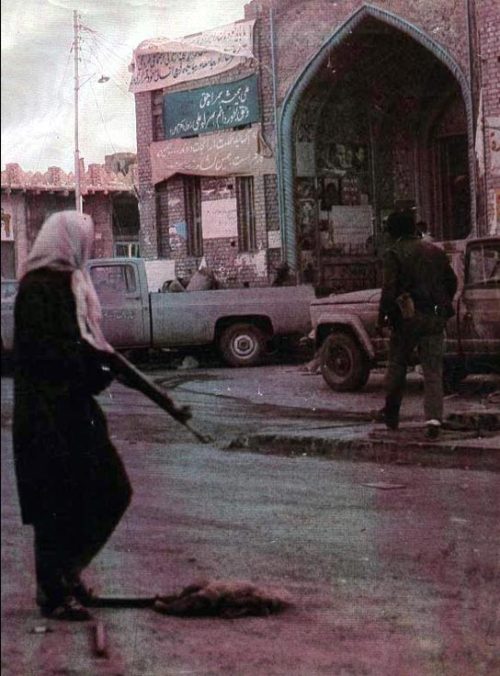#iran-iraq war
[Above Image] The war museum in Khorramshahr.
Khuzestan has a plethora of famous archaeological monuments dating back thousands of years, including the great Elamite zigguarat at Choghal Zambil; the first vaulted ceiling in the world at the royal grave at Haft Tapeh;theElamite city of Shush, where Hammurabi’s code was found;theAchaemenid palace of Shush, the bureaucratic heart of my own namesake’s 5th century empire; the tomb of the Biblical prophet Daniel; and the bridges built by the defeated Roman armies of Valerian.
But for the student of modern Iran, the most significant monuments in Khuzestan are those of the Iran-Iraq War. This was the longest conventional war in the 20th century, lasting from September 1980 to August 1988. About one million Iraqi and Iranian soldiers died, making it as well one of the century’s costliest. The war featured massive battles involving land mines and chemical warfare, attacks on oil tankers throughout the Persian Gulf, and attacks on both countries’ major cities using artillery and scud missiles.
The U.S. became involved in hostilities with Iranian forces several times, and it is important to remind Americans of this, because although most Iranians remember these incidents vividly, we for the most part do not. OnApril 14, 1988, a mine badly damaged the USS Roberts, and the U.S. responded with the largest naval engagement since World War II, fighting Iranian forces along the 900-mile coastline. During Operation Praying Mantis, as it was called, American vessels crippled or sank six Iranian ships and two oil platforms in a mere nine hours. No American lives or ships were lost; the Iranians, however, suffered heavy casualties.
In an incident perhaps even more significant for Iranians, in July 1988, the cruiser USS Vincennes shot down Iran Air Flight 655, killing all 290 civilian passengers on board. The Vincennes launched its missiles from within Iranian territorial waters, Admiral Crowe later reluctantly admitted; the U.S. paid compensation but never formally apologized. The actions of the Vincennes’ commander have been carefully analyzed by Lieutenant Colonel David Evans of the U.S. Marine Corps; the incident is now a case study used in naval academies to teach what not to do in similar circumstances. After reading Evans’ devastating reconstruction of events, it is hard not to conclude that the commander of the Vincennes deliberately shot down a civilian aircraft.But these events, while important in retrospect, were not the heart of the fighting in the province of Khuzestan. Early in the war, the Iraqis advanced well into Iranian territory in Khuzestan, grinding to a halt at the foothills of the Zagros, a 700-mile-long mountain chain stretching from the Caucusus to the Persian Gulf. The Iranians counterattacked, and the battle for Khorramshahr was engaged.
Until the outbreak of war, the city of Khorramshahr on the Shatt al Arab was one of the most cosmopolitan cities in Iran. It had a population of 150,000 and numerous foreign consulates. It was a major port and trading city.
During the first Battle of Khorramshahr (1980), it took the Iraqi army almost a month to occupy the city, at the cost of about 6,000 casualties.Although Khorramshahr was defended by 3,000 ill-equipped, ill-trained Iranian soldiers, the population soon joined them. By the end of the battle, the city was depopulated. During the second Battle of Khorramshahr (1982), the Iranian army took back the city with huge wave attacks and reportedly suffered heavy casualties. Survivors describe the battle much like Americans describe D-Day. Once the city was taken, Iranians poured into the streets and exchanged sweets.
–From the Inside, Looking In: Sickness, War, and Remembrance in Iran, by Darius Rejali. 2007.
The essay is adapted from a talk given by Reed political science professor Darius Rejali at the conclusion of the Fall 2006 Public Policy Lecture Series, Understanding Iran: Images and Realities.
Post link

Persepolis: The Story of a Childhood, Marjane Satrapi
(2000)
trans. Blake Ferris, Mattias Ripa (2003)
An armed Iranian militia woman in front of a mosque during the Iraqi invasion of Khorramshahr, September–October 1980
Post link

![[Above Image] The war museum in Khorramshahr. Khuzestan has a plethora of famous archaeological monu [Above Image] The war museum in Khorramshahr. Khuzestan has a plethora of famous archaeological monu](https://64.media.tumblr.com/6212b6281e70697299ec81cd81954593/tumblr_oqh42umFKW1qh6o2ho1_400.jpg)


